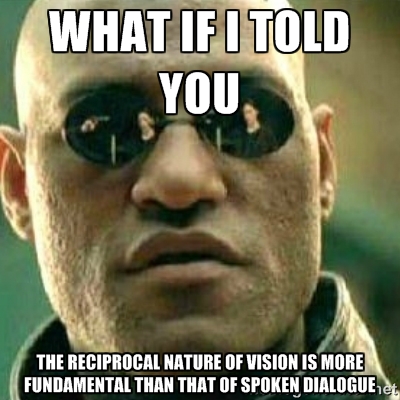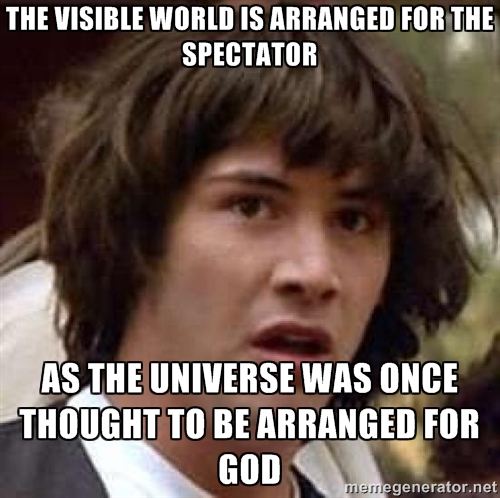

Recently, as I was rereading John Berger’s Ways of Seeing along with a small section from Ludwig Wittgenstein’s Philosophical Investigations, I was highly conscious of the fact that Berger’s writing already seemed suited to image macros (as evidenced by their use in my examples here). Berger’s suitability owes, in part perhaps, because
1. His grammar is already gnomic, simplified, and compact in its interpretative moments. Berger’s textual style is actually a great lens to read meme grammar through, since like image captions, he uses predominately active verbs, few compound sentences, and his syntax often contains a small rhetorical pivot point upon which the totality of the Grand Argument rests. (Although I recognize that I have selected two similar meme-types for my Berger quotes. My meme-Berger connection breaks down if I insert his text in an insanity wolf image macro. The effect becomes something else. Textual-visual codes not meeting squarely.)
2. More broadly, Berger’s text is dependent on highly mediated reproductions of oil paintings, nudes, and advertising photographs to carry the weight of his textual analysis on human perception. (I’m toying with the idea that Berger and Wittgenstein are themselves historical meme-machines.)
Still, I don’t mean to imply that memes—and I’m thinking specifically of image macros here—are “the scholar’s art,” but, just as Berger merges text and image to generate the thrust of his argument, memes arguably serve a similar function as small frames of cultural interpretation—frames that assist the interpretation of human perception. Not to take up the position of Captain Obvious, but the gnomic, condensed quality of the meme caption is expressive of this interpretative frame.
gnomimetic remix
Good Guy Gandhi ·
gnomimetic remix with benjamin
wonka reduction ·
gnomimesis is magic
Talan Memmott
Davin Heckman
Claire Donato
Sergio Figueiredo
Jeremy Hight
Jeff T. Johnson
Kelly Lydick
Mark Marino
Craig Saper
Orchid Tierney
Erik Zepka
I wonder now what happens if we cross signals. If for example we have a sense of the tenor of insanity wolf, so that we could remove the image and still “see” it if the text is in place over a blank background, what would be the effect of pairing that text with a different macro—overly attached girlfriend, scumbag steve, or bad luck brian? We’re familiar with the phenomenon of one macro refering to another—intertextual memes—but how might body-swap memes work (or not work)?
Update, as I read “Image Macros as Public Discourse”:
The writer considers this possibility as a way to underscore the distinct operations of each macro. Their point is well taken, but it does seem like there is the potential here for productive dissonance between image types and associated/disassociated message types. If we think of memes as internet writing, we can attend to the phenomenon while experimenting with it (just as experimental writers in other forms and formats play with convention). This returns me to the "Call To Memes." Which begs the question: Is critique (and critical self-awareness) already embedded in memes—particularly to the extent that, to rework McLuhan, “The medium is the meme”?